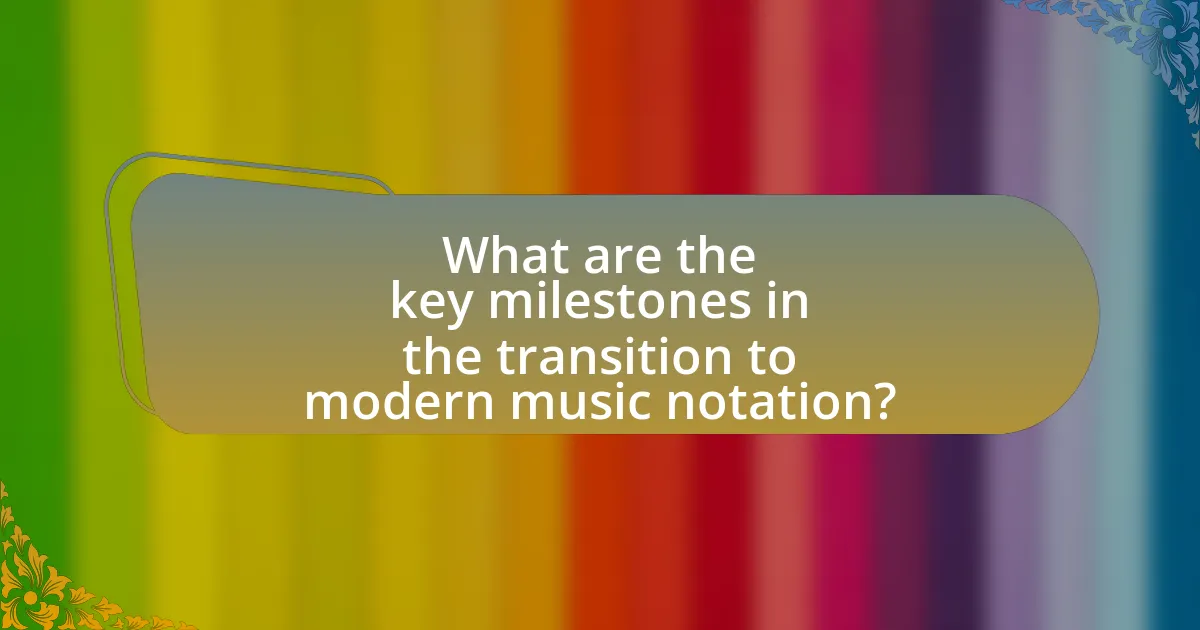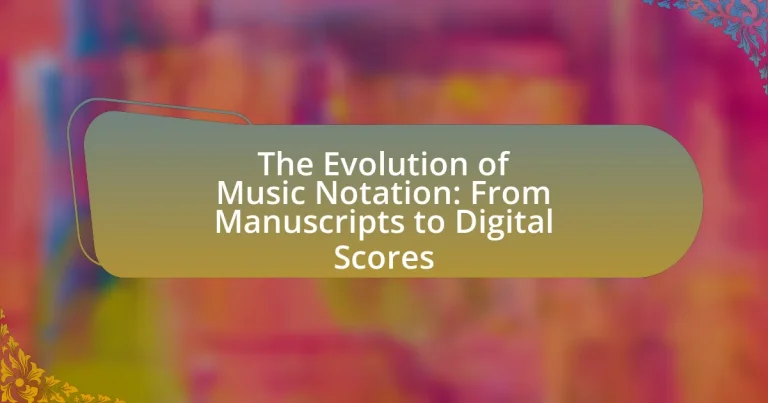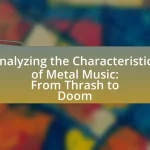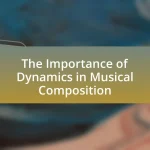The article examines the evolution of music notation, tracing its development from early neumatic systems in the 9th century to modern digital scores. It highlights key milestones, including the introduction of staff notation by Guido of Arezzo, the advancements during the Renaissance and Baroque periods, and the impact of printing on standardizing notation practices. Additionally, the article discusses the influence of technology in the 20th century, particularly the emergence of digital notation software and MIDI, which have transformed music creation and accessibility. Current trends and future directions in music notation are also explored, emphasizing the role of online platforms and collaborative tools in shaping contemporary practices.

What is the Evolution of Music Notation?
The evolution of music notation has progressed from early neumatic systems to modern digital scores. Initially, music was notated using neumes in the 9th century, which indicated pitch but lacked precise rhythmic values. By the 11th century, Guido of Arezzo introduced staff notation, allowing for clearer representation of pitch and rhythm. The Renaissance period saw the development of mensural notation, which provided more complex rhythmic structures. The 19th century introduced standardized notation practices, leading to the modern five-line staff system widely used today. With the advent of technology, digital notation software emerged in the late 20th century, enabling composers to create, edit, and share music more efficiently. This progression reflects the ongoing adaptation of music notation to meet the needs of composers and performers throughout history.
How did music notation begin in ancient cultures?
Music notation began in ancient cultures as a system to represent musical sounds through symbols. The earliest known form of music notation can be traced back to the Sumerians around 3000 BCE, who used cuneiform script to document hymns and rituals. Similarly, ancient Greeks developed a notation system using letters and symbols to indicate pitch and duration, which was documented in texts like the “Hymn to Apollo.” These early notations served to preserve musical traditions and facilitate performance, demonstrating the importance of written music in cultural and religious practices.
What were the earliest forms of music notation?
The earliest forms of music notation were neumes, which originated in the 9th century. Neumes were simple symbols placed above the text of Gregorian chant to indicate pitch and melodic contour. These early notations did not specify exact pitches or rhythms but served as a guide for singers. The development of neumes laid the foundation for more complex systems of notation, such as staff notation, which emerged in the 11th century, allowing for greater precision in musical representation.
How did oral traditions influence early music notation?
Oral traditions significantly influenced early music notation by serving as the primary means of preserving and transmitting musical knowledge before the advent of written systems. These traditions relied on memory and repetition, which necessitated the development of notation systems to capture complex melodies and rhythms accurately. For instance, the use of neumes in Gregorian chant notation emerged as a way to represent pitch and melodic contour, reflecting the oral practices of singing and teaching music in monastic communities. This transition from oral to written forms allowed for greater consistency and dissemination of musical works, as evidenced by the widespread adoption of these notational systems across Europe during the Middle Ages.
What significant changes occurred during the Medieval period?
Significant changes during the Medieval period include the development of music notation, which transitioned from neumatic notation to more structured forms like staff notation. This evolution allowed for greater precision in musical transcription and communication. The introduction of the staff system in the 9th century, attributed to the work of musicians such as Guido of Arezzo, facilitated the representation of pitch and rhythm, enhancing the ability to preserve and disseminate music. Additionally, the rise of polyphony in the late Medieval period further transformed musical composition and performance practices, leading to richer harmonic textures.
How did Gregorian chant impact music notation development?
Gregorian chant significantly influenced the development of music notation by introducing the use of neumes, which were early symbols representing pitch and rhythm. These neumes allowed for the transcription of melodies, facilitating the preservation and dissemination of chant repertoire. As a result, the need for more precise notation led to the evolution of staff notation in the 9th century, which provided a clearer framework for indicating pitch and duration. This transition from neumes to staff notation marked a crucial advancement in music notation, enabling composers to write more complex music and contributing to the overall evolution of Western music.
What innovations were introduced in the notation system during this time?
During this time, significant innovations in the notation system included the introduction of staff notation, which allowed for precise pitch representation, and the use of rhythmic notation, enabling composers to convey timing more effectively. Staff notation, developed in the 9th century, utilized horizontal lines to indicate different pitches, while rhythmic notation evolved in the 13th century, incorporating note shapes to represent varying durations. These advancements facilitated more complex musical compositions and improved communication among musicians, marking a pivotal shift from earlier manuscript traditions.
How did the Renaissance and Baroque periods shape music notation?
The Renaissance and Baroque periods significantly shaped music notation by introducing standardized systems that enhanced clarity and precision in musical scores. During the Renaissance, the development of staff notation, particularly the use of five lines, allowed for more accurate representation of pitch and rhythm, facilitating complex polyphonic compositions. The Baroque period further refined these notational practices by incorporating features such as figured bass and ornamentation symbols, which provided performers with interpretative guidance. These advancements laid the groundwork for modern music notation, establishing conventions that are still in use today, such as the use of clefs, note values, and dynamic markings.
What new symbols and systems emerged during the Renaissance?
During the Renaissance, new symbols and systems such as the staff notation system and the use of clefs emerged, revolutionizing music notation. The staff notation system, consisting of five lines and four spaces, allowed for precise pitch representation, while the introduction of clefs, such as the treble and bass clefs, provided a framework for indicating the pitch range of different instruments and voices. These innovations facilitated the composition and performance of increasingly complex polyphonic music, as evidenced by the works of composers like Josquin des Prez and Palestrina, who utilized these notational advancements to enhance musical expression and clarity.
How did composers influence the evolution of notation in the Baroque period?
Composers significantly influenced the evolution of notation in the Baroque period by introducing more complex musical forms and requiring greater precision in written music. This period saw the transition from simple, linear notation to more intricate systems that could accurately represent dynamics, articulations, and ornamentations. For instance, composers like Johann Sebastian Bach and Antonio Vivaldi utilized figured bass and explicit notational symbols to convey their musical intentions, which led to the standardization of these practices in scores. The increased demand for clarity in notation allowed for the development of new symbols and conventions, such as the use of slurs and dynamics markings, which became essential for performers to interpret the music accurately.

What are the key milestones in the transition to modern music notation?
The key milestones in the transition to modern music notation include the development of neumes in the 9th century, the introduction of staff notation in the 11th century, the establishment of the five-line staff by Guido of Arezzo, the adoption of mensural notation in the 14th century, and the standardization of notation practices in the 16th century. Neumes represented early attempts to indicate pitch and rhythm, while staff notation allowed for more precise musical representation. Guido of Arezzo’s innovations facilitated sight-singing and music education. Mensural notation introduced rhythmic values, and the 16th century saw the emergence of a more uniform system that laid the groundwork for contemporary notation. These milestones collectively reflect the evolution from rudimentary symbols to a comprehensive system that supports complex musical compositions.
How did the invention of printing affect music notation?
The invention of printing significantly transformed music notation by enabling the mass production of musical scores, which increased accessibility and standardization. Prior to printing, music was laboriously copied by hand, leading to variations and errors in notation. The introduction of movable type printing in the 15th century, particularly by Johannes Gutenberg, allowed for the efficient reproduction of music, exemplified by the publication of the first printed music book, “Harmonice Musices Odhecaton” by Ottaviano Petrucci in 1501. This innovation not only facilitated the widespread distribution of music but also contributed to the establishment of consistent notation practices, thereby enhancing the learning and performance of music across Europe.
What role did music publishers play in standardizing notation?
Music publishers played a crucial role in standardizing notation by creating consistent formats for printed music, which facilitated widespread dissemination and uniformity in musical scores. In the 16th to 19th centuries, publishers like Ottaviano Petrucci and later firms established specific conventions for note shapes, spacing, and layout, which helped musicians interpret compositions accurately. This standardization was essential for the development of a shared musical language, enabling composers and performers across different regions to communicate effectively through written music. The introduction of engraving techniques further enhanced the clarity and consistency of notation, solidifying the publisher’s influence in shaping modern music notation practices.
How did the rise of music education influence notation practices?
The rise of music education significantly influenced notation practices by standardizing musical symbols and methods of teaching. As formal music education became more prevalent in the 18th and 19th centuries, institutions began to adopt consistent notation systems, which facilitated clearer communication among musicians. This standardization was essential for teaching and learning, as it allowed students to read and interpret music more effectively. For instance, the establishment of music conservatories and the publication of instructional materials led to the widespread use of the staff notation system, which became the foundation for Western music notation. Consequently, this evolution in notation practices not only improved the accuracy of musical performance but also enhanced the accessibility of music education to a broader audience.
What technological advancements have impacted music notation in the 20th century?
Technological advancements that have impacted music notation in the 20th century include the development of music engraving software, MIDI (Musical Instrument Digital Interface), and digital audio workstations (DAWs). Music engraving software, such as Sibelius and Finale, revolutionized the way composers and arrangers create and print sheet music, allowing for greater precision and ease of editing. MIDI technology, introduced in the early 1980s, enabled electronic instruments to communicate with computers, facilitating the integration of notation software with digital music production. Additionally, DAWs provided platforms for composers to not only notate music but also produce and manipulate audio, further transforming the landscape of music creation and notation. These advancements collectively enhanced accessibility, efficiency, and creativity in music notation practices throughout the century.
How did the introduction of electronic instruments change notation?
The introduction of electronic instruments significantly changed music notation by necessitating new symbols and formats to accurately represent the unique sounds and capabilities of these instruments. Traditional notation, primarily designed for acoustic instruments, lacked the ability to convey the complexities of electronic sounds, such as synthesized tones and effects. As a result, composers began to develop graphic notations and extended techniques that could illustrate the electronic instrument’s capabilities, including pitch bending, modulation, and timbral variations. This evolution in notation reflects the broader shift in music composition and performance practices, as seen in the works of composers like Karlheinz Stockhausen and John Cage, who embraced electronic music and its distinct characteristics.
What is the significance of MIDI in modern music notation?
MIDI, or Musical Instrument Digital Interface, is significant in modern music notation as it enables the digital representation and manipulation of musical information. This technology allows composers and musicians to create, edit, and playback music using software and hardware instruments, streamlining the process of music production. MIDI facilitates the integration of various digital audio workstations (DAWs) and synthesizers, making it easier to compose complex arrangements without the limitations of traditional notation. Furthermore, MIDI supports a wide range of musical parameters, such as pitch, velocity, and timing, which enhances the expressive capabilities of digital music. The widespread adoption of MIDI since its introduction in 1983 has transformed how music is created and shared, establishing it as a foundational element in contemporary music notation practices.
How has digital technology transformed music notation today?
Digital technology has transformed music notation today by enabling the creation, editing, and sharing of scores through software applications. These applications, such as Sibelius and Finale, allow composers and musicians to notate music with precision and ease, utilizing features like playback, automatic formatting, and real-time collaboration. The shift from traditional manuscript writing to digital notation has increased accessibility, allowing users to share scores instantly online and facilitating remote collaboration among musicians. Additionally, digital technology supports various file formats, such as MusicXML and MIDI, which enhance interoperability between different music software, further streamlining the music creation process.
What are the benefits of using digital scores over traditional manuscripts?
Digital scores offer several benefits over traditional manuscripts, including enhanced accessibility, ease of editing, and improved collaboration. Digital scores can be accessed on various devices, allowing musicians to carry an entire library without physical limitations. Additionally, editing digital scores is straightforward, enabling quick adjustments to notation, dynamics, and other elements, which is cumbersome with paper. Furthermore, digital platforms facilitate real-time collaboration among musicians, allowing for instant sharing and feedback, which is not possible with traditional manuscripts. These advantages contribute to a more efficient and flexible approach to music creation and performance.
How do software programs facilitate music notation for composers?
Software programs facilitate music notation for composers by providing digital tools that streamline the process of creating, editing, and printing musical scores. These programs, such as Sibelius and Finale, allow composers to input notes using MIDI instruments or computer keyboards, significantly reducing the time required compared to traditional hand notation. Additionally, they offer features like automatic formatting, playback capabilities, and the ability to easily transpose music, which enhances the composer’s workflow. Research indicates that the use of notation software has increased productivity among composers, with studies showing that composers can produce scores up to 50% faster when using these digital tools compared to manual methods.

What are the current trends and future directions in music notation?
Current trends in music notation include the increasing use of digital platforms for composition and sharing, as well as the integration of interactive elements in scores. Digital notation software, such as MuseScore and Sibelius, allows composers to create, edit, and distribute music more efficiently, reflecting a shift from traditional manuscript methods. Future directions suggest a greater emphasis on accessibility, with tools designed for visually impaired musicians and the incorporation of artificial intelligence to assist in composition and arrangement. These advancements are supported by the growing adoption of technology in music education and performance, indicating a transformative phase in how music is notated and experienced.
How is music notation evolving with the rise of online platforms?
Music notation is evolving significantly with the rise of online platforms, primarily through increased accessibility and collaborative tools. Online platforms like MuseScore and Noteflight allow musicians to create, share, and edit scores in real-time, fostering a community-driven approach to music composition. This shift is supported by the fact that over 1.5 million users engage with these platforms, highlighting the demand for digital notation solutions. Additionally, the integration of multimedia elements, such as audio playback and interactive features, enhances the learning and teaching of music notation, making it more engaging and effective.
What role do collaborative tools play in modern music notation?
Collaborative tools play a crucial role in modern music notation by enabling real-time collaboration among composers, musicians, and arrangers. These tools facilitate the sharing and editing of musical scores across different locations, allowing multiple users to contribute simultaneously, which enhances creativity and efficiency in the composition process. For instance, platforms like MuseScore and Noteflight allow users to comment, suggest changes, and make edits in a shared environment, streamlining the workflow and reducing the time required to finalize compositions. This collaborative approach reflects the shift from traditional, isolated methods of music creation to a more interconnected and dynamic process, aligning with the broader evolution of music notation from manuscripts to digital formats.
How are mobile applications changing the way musicians access notation?
Mobile applications are revolutionizing how musicians access notation by providing instant, portable access to a vast library of digital scores. These applications enable musicians to view, annotate, and share sheet music on devices like smartphones and tablets, eliminating the need for physical copies. For instance, platforms like MuseScore and Notion offer extensive catalogs of user-generated and professionally published scores, allowing musicians to find specific pieces quickly. Additionally, features such as real-time collaboration and cloud storage enhance accessibility and convenience, making it easier for musicians to practice and perform with up-to-date materials. This shift towards digital notation is supported by the increasing adoption of mobile technology in music education and performance, reflecting a broader trend in the music industry towards digital solutions.
What challenges do musicians face with digital notation?
Musicians face several challenges with digital notation, including software compatibility issues, a steep learning curve, and the potential for technical malfunctions. Software compatibility issues arise when different digital notation programs do not support the same file formats, making it difficult for musicians to share and collaborate on scores. The steep learning curve is evident as many musicians must invest significant time to become proficient in using complex notation software, which can detract from their practice and performance time. Additionally, technical malfunctions, such as software crashes or hardware failures, can disrupt the creative process and lead to loss of work, causing frustration and delays in music production. These challenges highlight the need for musicians to adapt to evolving technology while maintaining their artistic integrity.
How can musicians ensure the accuracy of digital scores?
Musicians can ensure the accuracy of digital scores by utilizing reliable music notation software and regularly verifying the scores against original manuscripts or trusted editions. High-quality software, such as Sibelius or Finale, incorporates features that minimize errors during transcription and playback, allowing musicians to catch discrepancies early. Additionally, musicians should engage in peer reviews or collaborate with other musicians to cross-check the digital scores, which can help identify mistakes that may have been overlooked. Research indicates that collaborative verification significantly reduces errors in digital scores, enhancing overall accuracy.
What are common pitfalls when transitioning from paper to digital notation?
Common pitfalls when transitioning from paper to digital notation include loss of formatting, inadequate software training, and data compatibility issues. Loss of formatting occurs when digital tools do not accurately replicate the visual layout of traditional scores, leading to misinterpretation. Inadequate software training can hinder users from fully utilizing features, resulting in inefficient workflows. Data compatibility issues arise when different software programs cannot share files seamlessly, causing frustration and potential loss of work. These pitfalls can significantly impact the effectiveness of digital notation adoption in music.
What best practices should musicians follow when using digital notation tools?
Musicians should ensure accuracy and clarity when using digital notation tools by regularly proofreading their scores and utilizing built-in features for error detection. This practice helps to maintain high-quality compositions and reduces the likelihood of performance mistakes. Additionally, musicians should familiarize themselves with the software’s capabilities, such as playback functions and formatting options, to enhance their workflow and presentation. Research indicates that effective use of digital notation tools can significantly improve the efficiency of music composition and arrangement, as noted in studies on digital music production techniques.


